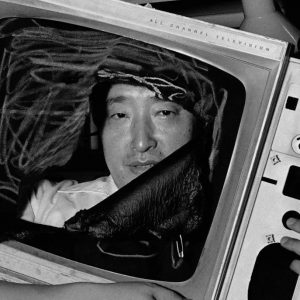TV Buddha, 1974(2002)
CCTV video installation (1 limestone Buddha statue, 1 CRT TV set, 1 video camera)
Live feed transmission (colour, silent)

Nam June Paik, TV Buddha, 1974 (2002), Installation view, OCAT Shanghai, 2020.
Image courtesy of OCAT Shanghai.
*TV Buddha presented in Refocusing on the Medium: the Rise of East Asia Video Art is live broadcasted in cooperation with the Nam June Paik Art Center’s current exhibition Nam June Paik TV Wave.

Nam June Paik, TV Buddha, 1974(2002), Installation view, Nam June Paik Art Center’s current exhibition Nam June Paik TV Wave, 2020. Image courtesy of Nam June Paik Art Center ©Nam June Paik Estate.
Click the image to watch the live stream of this work.

- In partnership with the Nam June Paik Art Center in South Korea, a live stream broadcast of the iconic Nam June Paik video installation TV Buddha, 1974(2002) is projected in the entry foyer of the exhibition. The live stream broadcast of the video installation comes from their current exhibition Nam June Paik – Video Wave. The projection is a direct provocation to question the video medium within the context of the exhibition – the liveness of the medium, the distortion of time and space, the tension between illusion, reality, and authentic experience, the conceptual strategies that subvert the medium, and the dynamics connecting local and global aspirations. This first encounter establishes the connection between Nam June Paik’s reflection on the medium and offers through the ‘live stillness’ of TV Buddha a proposition, an attitude toward the video medium that raises questions to model ways we might refocus and reconsider the video medium. (Text / Kim Machan)
- Nam June Paik
1932-2006, Seoul, South Korea
Born in Seoul, South Korea in 1932, Nam June Paik spent his middle school days in Seoul and Hong Kong, and his high-school days in Kamakura, Japan. He studied aesthetics in the University of Tokyo, with a graduation thesis on Arnold Schoenberg. Moving to Germany in 1956 and studying European philosophy and modern music, he came to work actively with contemporary avant-garde artists and began to carve out his artist-identity by doing radical performances that were completely different from artistic canons and conventions back then. Afterward, he pursued a novel path of art-making by means of new media. His media art gained momentum by his first solo show Exposition of Music-Electronic Television in which he presented televisions with inner circuits modified and manipulated, as a work of art.Paik is a pioneering media artist working with various technologies in creative and experimental ways. He saw the artist’s role as consisting in thinking about the future and sought better ways of global communication through art. Regarded as “one of the forerunners of a new breed of artists who are scientists, philosophers and engineers at the same time” and as “a very special and genuine genius and futurologist with foresight” Paik still lives on with us right here as “the most contemporary artist” today.


